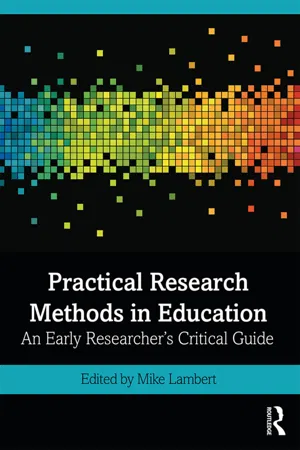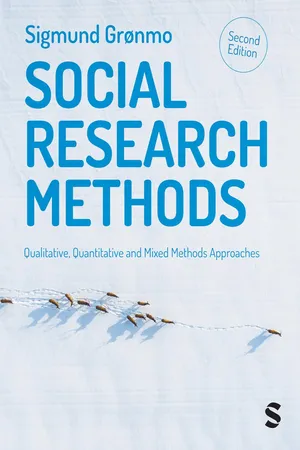Psychology
Quantitative and Qualitative Data
Quantitative data in psychology refers to numerical information that can be measured and analyzed using statistical methods, such as test scores or reaction times. Qualitative data, on the other hand, involves non-numeric information that is descriptive and subjective, such as observations or interviews. Both types of data are valuable in psychological research, providing different insights and perspectives.
Written by Perlego with AI-assistance
Related key terms
11 Key excerpts on "Quantitative and Qualitative Data"
- eBook - ePub
- Walter Amedzro St-Hilaire(Author)
- 2018(Publication Date)
- WSPC(Publisher)
PART IIITHE USE AND MANAGEMENT OF Quantitative and Qualitative DataPassage contains an image
CHAPTER 7THE ACQUISITION OF Quantitative and Qualitative Data IN INDUSTRIAL RELATIONSIn a research, the use of data is not limited to the record of observations related to the concepts involved in the research question. Indeed, once the research question has been formulated, the researcher, at various stages of progress in his research, turns to various sources of data to obtain the inspiration he needs to continue the process (literature review, interviews with experts, etc.), or to collect the information on which its analysis will be based (participating observations, interviews, phenomenon measurements, performance measures, etc.). This data is quantitative or qualitative.Quantitative data is data whose accuracy is essential for the research that uses it. Indeed, the use of these data testifies to the interest in objective characterization, as well as to rigorous and systematic quantification or for comparisons of the dimensions of a variable. The linking of the concepts translated into operative variables (explanatory independent variables and dependent variables to explain) and the identification of the possible links of causality between them depend on the quality and the rigor of the information conveyed by these data. For their part, qualitative data facilitate the exploration and collection of subjective opinions. They make it possible to describe a phenomenon in detail and to understand the subtleties that quantitative data cannot capture.Whether quantitative or qualitative, the quality of the data collected as part of a research is decisive for the usefulness and scientific relevance of the study. They must therefore be appropriate and allow to account, faithfully and as completely as possible, the concepts involved in the research hypotheses. The researcher must, on the one hand, identify the key moments in the research in which he must obtain information, the type of information he needs, and the means that are best suited to obtain data of this nature. On the other hand, it must be able to apply these means adequately, that is to say, so that their application does not affect the quality and relevance of information. For this, it respects a set of principles, makes sure to master the requirements and particularities of the techniques it implements and carefully selects its sources of information. - eBook - ePub
Practical Research Methods in Education
An Early Researcher's Critical Guide
- Mike Lambert, Mike Lambert(Authors)
- 2019(Publication Date)
- Routledge(Publisher)
It is still common for researchers working in the education field to regard ‘quantitative-qualitative’ as a methodological divide, in which they have to choose a side. This chapter rejects this view, taking as its starting point the notion that researchers should view them merely as different types of data and that they therefore need to understand how both are collected, analysed and interpreted. As using the quantitative option can seem particularly problematic, here are three reasons why readers who are nervous of numbers should consider familiarizing themselves with quantitative data processes:What is quantitative research? What are quantitative data?• Having some understanding of quantitative data will improve your ability to assess investigations which use quantitative approaches, particularly if you are new to research.• Being able to incorporate quantitative data into your own research could strengthen its impact, particularly if you are interested in influencing aspects of education practice or policy. Although they often use them carelessly and unreflectively, policymakers like numbers.• Having an improved understanding of quantitative data and research will put you in a better position to evaluate or conduct mixed-methods investigations.The application of quantitative methods in social-science research derives from interest in the 19th century in experimental investigation in the natural sciences. This sought to understand the processes of cause and effect through manipulation and controlled testing. However, it became clear that many of the issues explored in social sciences, such as education, do not lend themselves well to experimental approaches, so researchers began from the 1950s to apply them to what became known as ‘quasi-experimental’ and ‘non-experimental’ situations – these approaches are considered in more detail later in the chapter.Provocatively, Berliner (2002:19) has described what social scientists, and particularly educational researchers, do as the ‘hardest to do science […] because humans in schools are embedded in complex and changing networks of social interaction’. It is engaging with this social complexity that makes the application of experimental research to education so challenging (Hadfield and Jopling, 2018), and it is partly as a consequence of the need to address this complexity and the limitations of the persistent quantitative-qualitative divide, manifested in the so-called ‘paradigm wars’, that mixed-methods research design (Tashakkori and Teddlie, 1998) gained ground in the 1990s. - eBook - ePub
Social Research Methods
Qualitative, Quantitative and Mixed Methods Approaches
- Sigmund Grønmo(Author)
- 2023(Publication Date)
- SAGE Publications Ltd(Publisher)
In quantitative studies, the analysis and interpretation are usually conducted after the data collection is completed. The collection of quantitative data is not only highly structured. It is also carried out in a routine manner. The researcher usually only participates to a very small extent in the data collection process. In the quality of life study, the researchers did not participate in any part of the interviewing. Although it can also be an advantage in quantitative studies for the researcher to have as good a knowledge as possible of the primary sources, such studies are often so extensive that it is impossible for the researcher to obtain an overview of more than a limited portion of the primary data. This is especially true of the quality of life study, which includes interviews with nearly 37,000 people in 33 different countries. However, since the data recording is structured and the data are quantified, it is possible to process and analyse these large data sets using statistical techniques. Structuring, quantification and statistical calculations help to reach precise conclusions, as well as to keep track of large amounts of data. In other words, precision and overview are prominent features of quantitative analyses. Being able to process large amounts of data can also provide a basis for examining and evaluating relationships that apply to relatively wide-ranging social conditions. On the other hand, there is a risk that the analysis results in limited insight into the conditions studied. It is possible that not only the data collection, but also the analyses and the interpretations may become too routine. The utilization of the data can become a matter of purely technical skills. This could cause the entire study to be characterized by a lack of imagination, creativity and originality.Presentation of the results of the analysis
A fourth difference between qualitative and quantitative analyses relates to the presentation of the results. The different characteristics of the two types of data affect not only the processing of the data, but also the presentation of the findings resulting from the analysis. The most common form of presentation of qualitative data involves using quotations from observation notes, interview transcripts or documents for illustrative purposes. This is how the results of the election campaign study, the nursing study and the newspaper study were presented. General points, arguments, concepts or categories are exemplified, elaborated and explained by selecting relevant quotes from the data, putting them together and presenting them in the most appropriate manner. In combination, the quotes presented help to describe the phenomena being analysed. With this selection and compilation of quotes, the researcher usually strives to achieve as comprehensive a description as possible. Since the quotes largely reproduce the primary source’s own expressions and formulations, the description can be both detailed and nuanced at the same time. Thus, it can also be quite complex. There is a danger that the presentation will not only become unclear, but also too detailed. It can also be characterized by a lack of perspective, in that it may be difficult to distinguish between significant and insignificant aspects of the descriptions. On the other hand, a strict prioritization and selectiveness regarding the presentation of quotes may be problematic because the selection may be too strongly influenced by the researcher’s personal opinions and sociocultural background. Generally, the less analytical the description is, the greater these problems will be. - eBook - ePub
Doing Research in Social Work and Social Care
The Journey from Student to Practitioner Researcher
- Catherine Flynn, Fiona McDermott(Authors)
- 2016(Publication Date)
- SAGE Publications Ltd(Publisher)
8 Counting and Measuring1 Questionnaires, Scales and Secondary Analyses In this chapter you will learn About key features of some of the common quantitative data collection methods used in social work and social care research When and how to apply specific quantitative data collection measures in your research What data mining is and how to do it. Introduction This is the second of three chapters focused on understanding why, when and how to use particular data collection methods in social work and social care research. In the previous chapter, we outlined some common data gathering techniques involving speaking and listening, such as the use of interviews, focus groups and forums. In this chapter, we will examine some of the quantitative data collection methods often used in research in our professional fields. Let’s begin by noting the differences in the kinds of data that may be collected in social work and social care research. Qualitative data are non-numerical in nature (words), and describe a quality or a type, while quantitative data are numerical and measure a quantity or an amount. The choice of which type of data to collect is directly determined by the research question(s) posed (as discussed in Chapter 4). Even though methods are epistemologically free, choices are inevitably influenced by the researcher’s epistemological position as outlined in Chapter 2. Getting started with quantitative data Quantitative data are more often associated with addressing research questions originating in a positivist paradigm. These questions often aim to discover the nature of an objective reality through the use of the scientific method ; that is, a way of asking and answering questions which require the use of empirical observations and experiments, the development of hypotheses, and the use of quantitative measures which rely on deductive reasoning. This could include information that quantifies participants’ perceptions, experiences or attributes - eBook - ePub
- Graham C. Davey, Graham C. Davey(Authors)
- 2018(Publication Date)
- Wiley(Publisher)
- Findings published in scientific journals will reach a wider audience and peer review of submitted papers ensures that high quality is maintained. However, even published papers might be flawed and caution must be exercised when the results are being followed up.
- Publishing work in books is another means of dissemination but has the disadvantage of the results appearing dated because of the lengthy prepublication period.
- Broad exposure can come from talking to the media. However, the media are prone to oversimplification and may distort the findings to create a more dramatic story.
QUANTITATIVE RESEARCH METHODS
LEARNING OBJECTIVE 2.3
Demonstrate understanding of some of the quantitative methods used by psychologists.Psychologists use a wide variety of methods in order to study behaviour scientifically. Each has its own strengths and weaknesses, as outlined in the discussion below. In many cases, a psychological phenomenon will most fully be understood by tackling it with a variety of methods, a process known as ‘converging operations’.Most psychologists use ‘quantitative’ methods, investigating behaviour with procedures modelled on those used by the natural sciences. Typically they will use experiments and observational methods to obtain numerical data that are subjected to statistical analyses. A sizeable minority of psychologists use ‘qualitative’ methods, rejecting these quantitative methodologies in favour of more interpretative techniques such as in-depth interviewing and textual analysis.What constitutes ‘good’ research? Reliability, validity, and importanceGood research has three attributes: reliability, validity, and importance. Reliability simply refers to how reproducible the results are. If you did the study more than once, would you get similar results each time? Validity - eBook - ePub
Interaction Design
Beyond Human-Computer Interaction
- Yvonne Rogers, Helen Sharp, Jennifer Preece(Authors)
- 2023(Publication Date)
- Wiley(Publisher)
- Decide how best to enter it into spreadsheet software, for example, how to handle answers to closed-ended questions. Then enter the data and generate some graphical representations. As the dataset is likely to be small, think carefully about what, if any, graphical representations will provide meaningful summaries of the findings.
- Is there any data for which simple measures, such as percentages or averages, will be helpful? If so, calculate the three different types of average.
- Consider your qualitative data.
- Based on your refinement of the study question “improving the product,” identify some themes in the qualitative data, for example, what features of the product cause people difficulties? Did any of the participants suggest alternative designs or solutions? Refine your themes and collate extracts of data that support the theme.
- Identify any critical incidents in the data. These may arise from interviews, questionnaire responses, or observation. Describe these incidents carefully and choose one or two to analyze in more depth, focusing on the context in which they occurred.
- Collate your findings as a presentation and deliver them to a group of peers.
- Review the presentation and any questions from the audience. Consider how to improve the analysis and presentation.
Summary
This chapter described in detail the difference between qualitative and quantitative data and between qualitative and quantitative analysis.Quantitative and Qualitative Data can be analyzed for patterns and trends using simple techniques and graphical representations. Qualitative data may be analyzed inductively or deductively using a variety of approaches. Thematic analysis (an example of inductive analysis) and data categorization (an example of deductive analysis) are common approaches. Analytical frameworks include conversation analysis, discourse analysis, content analysis, interaction analysis, grounded theory, and systems-based approaches. - eBook - ePub
- Vicky Heap, Jaime Waters(Authors)
- 2019(Publication Date)
- Routledge(Publisher)
9 Data analysisCHAPTER OVERVIEWIntroduction• Introduction• Quantitative data analysis• Qualitative data analysis• Summary• Learning questionsAs a mixed methods researcher you must have the requisite skills to competently analyse both Quantitative and Qualitative Data. The purpose of this chapter is to offer easy-to-follow guidance on how to conduct a basic range of Quantitative and Qualitative Data analyses, which can be used in conjunction with the data collection methods outlined in Chapter 8 – Data collection methods. We focus here on providing clear information about foundational analysis techniques. This is because executing a simple method of analysis correctly can provide more convincing inferences than using a complicated technique poorly. Although the size and scope of this chapter do not allow for advanced techniques to be introduced, we do signpost you to other textbooks that are solely dedicated to data analysis.The chapter is split into two parts. First, we consider quantitative data analysis and outline how to undertake a range of statistical tests using SPSS. We start by explaining a range of core terms associated with quantitative data, including: levels of measurement, independent and dependent variables, and hypotheses. We then move on to detail how to conduct univariate and bivariate analyses, providing step-by-step SPSS instructions. Secondly, we focus on qualitative data analysis by providing an introduction to thematic analysis. We illustrate how the systematic process of searching for themes in the data can be undertaken by following five basic steps: authenticating the data, creating sensitising concepts, coding, moving from codes to themes, and generating themes. Overall, the analysis techniques outlined in this chapter will provide you with enough information to be able to generate quantitative and qualitative inferences from your data that can be used to create a set of meta-inferences for your mixed methods research project. - Terry Hanley, Clare Lennie, William West(Authors)
- 2012(Publication Date)
- SAGE Publications Ltd(Publisher)
The application of such statistical approaches leads to a clarity of articulating our research outcomes and inherently the data analysis holds, behind the scenes, an audit trail that adds to its validity and reliability. If William inputs a set of numbers into SPSS (originally, Statistical Package for the Social Sciences, but more commonly known by its initials) and I do too then we will both achieve the same result. The audit trails required in qualitative analysis are just as important (if not more so) in order to establish the validity of the findings and conclusions obtained (such issues are considered elsewhere in this text).Quantitative approaches require particular methods to the design of a study, such as the designs outlined at the start of this chapter. Now that we have considered some of the underlying principles of this type of research we move onto the nuts and bolts of data generation and analysis.Collecting numbers in therapy research: data generation
Let’s imagine that you have identified a question that you want to try to answer for a small research project. Your first job is to think about how you are going to collect the information in order to answer the question. We begin this section by considering the use of questionnaires and surveys, along with a consideration of their strengths and weaknesses, before moving on to the use of observations and how they might be incorporated into a quantitative design.Questionnaires and surveys
We are all probably very familiar with this method of data collection, and are probably aware too of its limitations! How many times have you walked through town and actively avoided somebody with a clipboard and pen who clearly wanted to ask some questions of you? One of the advantages of the use of questionnaires and surveys is that they potentially allow for a large population of people to be questioned; however, the response rate is often very small in terms of return. Questionnaires and surveys are widely used in counselling and psychotherapy in trying to understand what is going on in therapy and in understanding the professional context of counselling. They are attractive to researchers in terms of the potential large participant pool that might be accessed, but also in terms of the ease with which quantitative data might be analysed in terms of the inclusion of closed questions (answered by Yes or No) or the attaching of some sort of rating scale. Qualitative data from more open questions that might be included can also be coded to allow us to count up the number of times that participants refer to a particular theme in their open-ended answers, so allowing for a quantitative analysis to be undertaken.- eBook - ePub
Research Skills for Teachers
From research question to research design
- Beverley Moriarty(Author)
- 2020(Publication Date)
- Routledge(Publisher)
On first engagement with this chapter, you might also identify additional readings related to areas that are important for your particular research, which you explore deeply to complement your learning. The further readings listed at the end of this chapter are suggested starting points.Thinking ahead of time about how you will analyse your data before you commence your data collection is also important if you are required to document these plans in advance, perhaps as part of your research proposal. You may even take classes or training in how to use computer programs to enter and analyse or assist with the analysis of data. If your data are quantitative, some statistical training or guidance is likely to be required. There are also computer programs that can assist you to analyse qualitative data, although whether you need to use one of these programs if you have a small data set, can be decided with your research supervisor or lecturer.Later reading of this chapter, particularly the parts that align with your quantitative, qualitative or mixed-methods approach to your study, is likely to be undertaken when you are ready to enter or prepare your data for analysis. Where possible, entering data can be an ongoing process as the data become available. This is often the case with qualitative research, in which case data analysis commonly commences during data collection. When all the data are collected simultaneously, which is often the case with quantitative research data, input and analysis begin immediately after the data are collected.This chapter is organised around the methods of data collection (surveys/questionnaires, interviews and observations) that were the main focus of Chapter 6 - eBook - ePub
Participatory Action Research for Educational Leadership
Using Data-Driven Decision Making to Improve Schools
- E. Alana James, Margaret T. Milenkiewicz, Alan J. Bucknam(Authors)
- 2007(Publication Date)
- SAGE Publications, Inc(Publisher)
This chapter has clarified the use of several types of qualitative data. Comparison of data collected at different times, which uses different methods or populations, builds a strong analysis of the issues. The comparison also ensures that resulting actions take into account meanings, context, processes, and causality. Some types of qualitative data ask similar questions, and when compared, these data types verify the consistency of human experience across any given issue.However, there are times when qualitative data alone will not be sufficient to alleviate doubt about the outcomes achieved through PAR projects. As an example, in a hypothetical research project, 100% of the parents in a focus group, all with children from the same classroom, thought that the school did not offer worthwhile volunteer possibilities. Would that necessarily make it true? What if the researcher instead recorded that the five parents who attended the focus group had their children in the same class of 30 students and that a subsequent questionnaire distributed to the whole class showed that 65% of the parents reported the need for a greater range of volunteering possibilities? Both of the statements were true, and both quantified their results, but the reactions to the two reports, with two size samplings, might be very different.Reporting situations for large groups will likely be more valid, credible, and reliable by verifying results with quantitative forms of measurement. In the example case, the PAR team studying parent involvement designed a questionnaire to validate information originally acquired through a focus group. PAR researchers need to evaluate their data and ask, “If an experience that exists for a few students or parents also exists for many students or parents, does it exist for the population as a whole?” Larger populations are more easily studied using quantitative techniques that are covered in Chapter 6.Task 4.2: Data-Planning MatrixThe following exercise is adapted from Maxwell (1996, p. 83). Researchers can employ the exercise to plot individual and group needs for data in PAR projects. This planning matrix can be used for both qualitative and quantitative data, and we suggest that, like the logic model, PAR groups employ the task throughout multiple cycles of the PAR process. - eBook - ePub
Social Research Methods
For Students and Scholars of Theology and Religious Studies
- Joshua Iyadurai(Author)
- 2023(Publication Date)
Chapter 5 QUANTITATIVE RESEARCHQuantitative research is deductive and begins with a theory or hypothesis to investigate the relational dimensions among variables by collecting numerical data and analyzing them with statistical tools. As we have seen in Chapter 3, postpositivism is the philosophical base of quantitative research and reflects the natural sciences’ approach to studying the social world.Quantitative research identifies concepts, variables, or constructs based on a theory or hypothesis and measures them to examine the relationship or association among the variables. It collects numerical data using different methods from predetermined samples and analyzes them statistically to offer an explanation indicating the causal nature or the kind of a relationship that exists between variables and/or presents a descriptive explanation of the population.Researchers choose quantitative research when the study aims at measuring fine distinctions among the variables under examination, establishing causal relationship among variables, discovering the nature of relationship among variables, generalizing the results of the sample to the population, offering statistical description of the population, and making the study replicable. For quantitative research, the researcher collects numerical data through survey instruments, structured questions, controlled observation, pretests and posttests, and texts and documents for content analysis. It analyzes the data using appropriate statistical tools to answer the research questions.The main phases of quantitative research are the conceptual, data collection, data analysis, and reporting of results. Because quantitative research is deductive, based on a theory or a theoretical framework, you first develop a hypothesis that predicts the relationship between variables. Then you adopt a method to empirically test the hypothesis by measuring the variables. “Constructs are conceptualized at the theoretical (abstract) plane, while variables are operationalized and measured at the empirical (observational) plane” (Bhattacherjee 2012, 12). Before you step into the field to collect data, you must design the study with all clarity at the conceptual phase.
Index pages curate the most relevant extracts from our library of academic textbooks. They’ve been created using an in-house natural language model (NLM), each adding context and meaning to key research topics.










